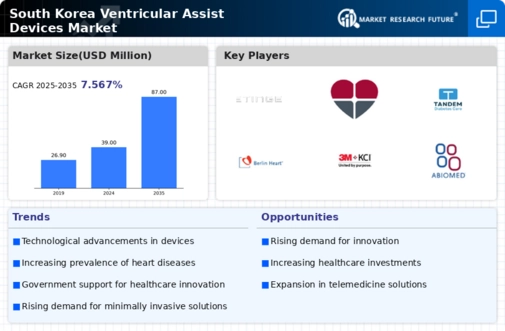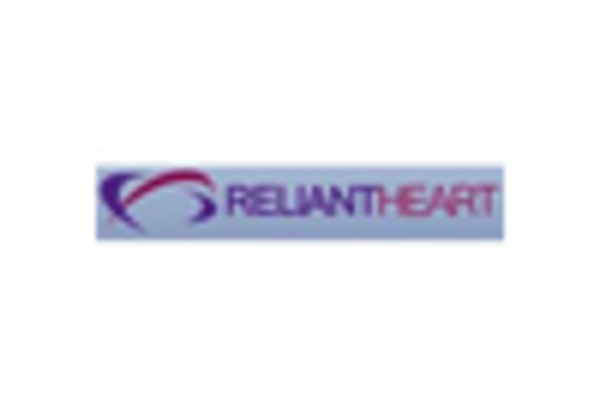Advancements in Medical Technology
Technological innovations in the field of medical devices are significantly influencing the ventricular assist-devices market. Recent developments have led to the creation of smaller, more efficient, and biocompatible devices that enhance patient comfort and outcomes. For instance, the introduction of continuous-flow devices has revolutionized treatment options, allowing for longer-lasting support with reduced complications. The South Korean market is witnessing a shift towards these advanced technologies, which are not only improving the quality of life for patients but also expanding the potential applications of ventricular assist devices. As healthcare systems increasingly adopt these innovations, the market is expected to experience substantial growth. The ongoing research and development efforts in this sector indicate a promising future for the ventricular assist-devices market, as manufacturers strive to deliver cutting-edge solutions that address the evolving needs of patients and healthcare providers.
Increasing Incidence of Heart Failure
The rising prevalence of heart failure in South Korea is a critical driver for the ventricular assist-devices market. According to recent health statistics, heart failure cases have surged, with estimates indicating that approximately 1 in 5 adults over the age of 65 may develop this condition. This alarming trend necessitates advanced treatment options, including ventricular assist devices, to manage severe heart failure effectively. The growing patient population requiring mechanical circulatory support is likely to propel the demand for these devices. Furthermore, as healthcare providers seek to improve patient outcomes, the integration of ventricular assist devices into treatment protocols appears increasingly essential. This trend suggests a robust market potential for manufacturers and suppliers within the ventricular assist-devices market, as they strive to meet the needs of a growing demographic facing heart-related challenges.
Aging Population and Healthcare Demand
The demographic shift towards an aging population in South Korea is a significant driver for the ventricular assist-devices market. With a growing number of elderly individuals, the demand for advanced cardiac care is likely to increase. Statistics reveal that by 2030, nearly 20% of the South Korean population will be aged 65 and older, a demographic that is particularly susceptible to heart diseases. This trend underscores the necessity for effective treatment options, including ventricular assist devices, to manage age-related cardiac conditions. As healthcare providers adapt to the needs of this aging population, the market for ventricular assist devices is expected to expand. The increasing focus on improving the quality of life for elderly patients further emphasizes the importance of these devices in contemporary healthcare strategies, suggesting a robust market outlook for the ventricular assist-devices market.
Rising Investment in Healthcare Infrastructure
The South Korean government's commitment to enhancing healthcare infrastructure is a pivotal factor driving the ventricular assist-devices market. Recent initiatives aimed at improving hospital facilities and expanding access to advanced medical technologies are likely to facilitate the adoption of ventricular assist devices. Increased funding for healthcare projects, including the establishment of specialized cardiac care centers, is expected to create a conducive environment for the growth of the market. Furthermore, as hospitals upgrade their capabilities to provide comprehensive cardiac care, the demand for innovative devices is anticipated to rise. This investment in healthcare infrastructure not only supports the availability of ventricular assist devices but also fosters an ecosystem that encourages research and development in this field. Consequently, the ventricular assist-devices market is poised for growth as healthcare systems evolve to meet the needs of patients requiring advanced cardiac support.
Enhanced Training and Education for Healthcare Professionals
The emphasis on training and education for healthcare professionals in South Korea is emerging as a crucial driver for the ventricular assist-devices market. As the complexity of managing patients with heart failure increases, the need for specialized knowledge in the use of ventricular assist devices becomes paramount. Initiatives aimed at providing comprehensive training programs for medical staff are likely to improve the understanding and application of these devices in clinical settings. Enhanced education not only equips healthcare providers with the necessary skills but also fosters confidence in utilizing advanced technologies. This, in turn, may lead to increased adoption rates of ventricular assist devices, as practitioners become more adept at integrating them into treatment protocols. The focus on professional development within the healthcare sector suggests a positive trajectory for the ventricular assist-devices market, as well-trained personnel are essential for optimizing patient outcomes.

















Leave a Comment